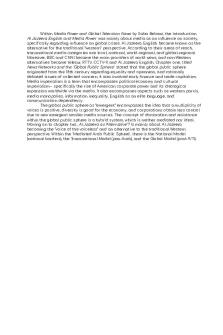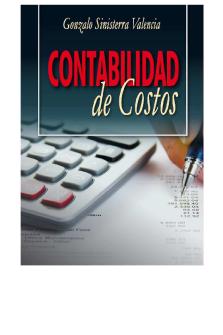C88 - L 7 - Professor Gonzales PDF

| Title | C88 - L 7 - Professor Gonzales |
|---|---|
| Author | Kayre Santos |
| Course | Communication Research Methods |
| Institution | University of California Santa Barbara |
| Pages | 3 |
| File Size | 161 KB |
| File Type | |
| Total Downloads | 65 |
| Total Views | 145 |
Summary
Professor Gonzales ...
Description
C 88 - L 7 ● NOIR - Nominal, Ordinal, Interval, Ratio ○ Nominal is the simplest, about categories ■ Ex. What’s your favorite color? Red, Blue, White, etc. ○ Ordinal is categories put in order ■ We know the order, but not the difference between each ○ Nominal and ordinal are noncontinuous ○ Interval is any measurement given in the form of a range ■ Ex. Rate how much you like your snack from 1 - 5 ○ Ratio ■ Has an absolute zero, there is nothing lower than zero ■ Ex. Weight, height, age ■ Normally a physical measure ■ Has ○ Ratios and integral are continuous ■ Can be expressed as a number or a fraction and still make sense ■ Ex. 144.789 cm ■ You would be able to average everyone’s scores ● Ex. On average, people gave this movie 4.6/5 stars
● ○
● ●
Pink Parscore
Internal Consistency: A Closer Look ○ When we make composite measures, we have to make sure they all go together
■
Ex.
●
● If we remove funny, we’ll have a higher internal reliability ○ Chronbach’s Alpha - We want it to be high, it’s between 0 - 1 ○ When we look at just credibility, it is unidimensional ■ When you collapse all these measures, it’s called an index Multiple Sets of Scales
●
Ex.
●
●
●
○ The green describes confidence and the grey describes expertise ○ This is why it’s a multidimensional index of credibility Coding Data ○ Often, we want to categorize data (AKA code it) ○ Pick up subthemes, which can be turned into themes ○ Usually we do this with observations or interview transcripts (non numerical) ○ Researchers may want to pick out recurring themes and put them together ○ The aim is to see emerging patterns - to help them see a bigger picture ○ Coding scheme - Rules by which to code ○ Ex. You take pictures of a certain phenomenon ■ You have a list of photo categories, (People on the phone, face to face, in business attire, etc.) ■ You can come up with a criteria on how to code your data ■ If 5 others repeated it and used your criteria, would you agree with them for where they place each photo? ■ You have to give a good coding scheme Reliability in Coded Data ○ You want to know how reliable the coding scheme is ○ You measure multiple coders choices and get a measure for intercoder reliability ○ You also want to know how consistent each coder is over multiple observations ■ If you had 20 different sets of 100 photos each time, and you repeated the task on each set, is it consistent? ○ When you measure the same coder’s choices, you get a measure for intra-coder reliability ■ How reliable is each coder compared to others? Validity of Measurement ○ Is it consistent? ■ Reliability ○ Does it match up to reality?
●
●
●
■ Validity ○ Does your measure really capture the concept you intend to be measuring? Valid Measures Should… ○ ...Be as true to what they’re measuring as we can expect them to be ○ Nothing is perfect, we try to get the most valid measures but can’t always ○ ...Have a good conceptual fit with variables in the hypothesis/RQs ○ ...Minimize potential “social desirability” bias effects ■ The tendency of survey respondents to answer questions in a manner that will be viewed favorably by others ■ Can take the form of over-reporting “good behavior” or under-reporting “bad” behavior Subjective vs. Objective Validity ○ It’s about the criteria you use to est. validity ○ Subjective Validity Ex. ■ They measure looks good on the face of it, based on your knowledge ■ According to my informed opinion, this is right ○ Objective Validity Ex. ■ I can predict the out come based on the prior studies, etc. ■ If a measure is shown to predict scored on an appropriate future measure within some acceptable margin ■ Ex. we expect SAT can predict college GPA ● If they have a relationship, then they are objectively valid Relationship between Reliability and Validity ○ Validity is harder to assess, needs more proof. Relatively is an easier formula ■ Something can be consistently wrong. Ex. A broken clock is consistently wrong, but not valid ○ Something cannot be valid but unreliable ○ You need both in science...
Similar Free PDFs

C88 - L 7 - Professor Gonzales
- 3 Pages

Wiki #7 - professor topoushian
- 1 Pages

COMM 89 - L 8 - Professor Morola
- 3 Pages

LLB203 Wk 7 L - Lecture notes 7
- 14 Pages

L 7- Redacción DE Párrafo
- 3 Pages

Gonzales v raich brief
- 2 Pages

Biologia Agustin Rosas Gonzales
- 3 Pages

Gonzales Cruz Diana M06S2AI4
- 4 Pages

Gonzales v. Williams
- 8 Pages

Reinaras- JOB Gonzales
- 1 Pages

Lecture 7 - Professor Mary Walsh
- 5 Pages

Hw chapter 7 - Professor Frega
- 6 Pages

Contabilidad-de-costos Gonzales
- 20 Pages
Popular Institutions
- Tinajero National High School - Annex
- Politeknik Caltex Riau
- Yokohama City University
- SGT University
- University of Al-Qadisiyah
- Divine Word College of Vigan
- Techniek College Rotterdam
- Universidade de Santiago
- Universiti Teknologi MARA Cawangan Johor Kampus Pasir Gudang
- Poltekkes Kemenkes Yogyakarta
- Baguio City National High School
- Colegio san marcos
- preparatoria uno
- Centro de Bachillerato Tecnológico Industrial y de Servicios No. 107
- Dalian Maritime University
- Quang Trung Secondary School
- Colegio Tecnológico en Informática
- Corporación Regional de Educación Superior
- Grupo CEDVA
- Dar Al Uloom University
- Centro de Estudios Preuniversitarios de la Universidad Nacional de Ingeniería
- 上智大学
- Aakash International School, Nuna Majara
- San Felipe Neri Catholic School
- Kang Chiao International School - New Taipei City
- Misamis Occidental National High School
- Institución Educativa Escuela Normal Juan Ladrilleros
- Kolehiyo ng Pantukan
- Batanes State College
- Instituto Continental
- Sekolah Menengah Kejuruan Kesehatan Kaltara (Tarakan)
- Colegio de La Inmaculada Concepcion - Cebu


